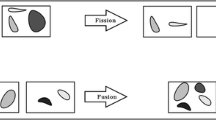Abstract
Brane calculi are a family of biologically inspired process calculi proposed in [3] for modeling the interactions of dynamically nested membranes.
In [3] a basic calculus for membranes interactions – called Phago/Exo/ Pino – is proposed, whose primitives are inspired by endocytosis and exocytosis. An alternative basic calculus – called Mate/Bud/Drip and inspired by membrane fusion and fission – is also outlined and shown to be encodable in Phago/Exo/Pino in [3].
In this paper we investigate and compare the expressiveness of such two calculi w.r.t. their ability to act as computational devices.
We show that (a fragment of) the Phago/Exo/Pino calculus is Turing powerful, by providing an encoding of Random Access Machines.
On the other hand, we show the impossibility to define a “faithful” encoding of Random Access Machines in the Mate/Bud/Drip calculus, by providing a proof of the decidability of the existence of a divergent computation in Mate/Bud/Drip.
Revised and full version of the extended abstract in Proc. Workshop on Computational Methods in Systems Biology, Edinburgh, April 2005.
Preview
Unable to display preview. Download preview PDF.
Similar content being viewed by others
References
Busi, N.: On the Computational Power of the Mate/Bud/Drip Brane Calculus: Interleaving vs. Maximal Parallelism. In: Freund, R., Păun, G., Rozenberg, G., Salomaa, A. (eds.) WMC 2005. LNCS, vol. 3850, pp. 144–158. Springer, Heidelberg (2006)
Busi, N., Zavattaro, G.: On the expressive power of movement and restriction in pure mobile ambients. Theoretical Computer Science 322, 477–515 (2004)
Cardelli, L.: Brane Calculi - Interactions of biological membranes. In: Danos, V., Schachter, V. (eds.) CMSB 2004. LNCS (LNBI), vol. 3082, pp. 257–278. Springer, Heidelberg (2005)
Cardelli, L.: Abstract Machines for System Biology. Draft (2005)
Cardelli, L., Gordon, A.D.: Mobile Ambients. Theoretical Computer Science 240(1), 177–213 (2000)
Cardelli, L., Păun, G.: An universality result for a (Mem) Brane Calculus based on mate/drip operations. International Journal of Foundations of Computer Science (to appear)
Danos, V., Pradalier, S.: Projective Brane Calculus. In: Danos, V., Schachter, V. (eds.) CMSB 2004. LNCS (LNBI), vol. 3082, pp. 134–148. Springer, Heidelberg (2005)
Finkel, A., Schnoebelen, P.: Well-Structured Transition Systems Everywhere! Theoretical Computer Science 256, 63–92 (2001)
Freund, R.: Asynchronous P Systems and P Systems Working in the Sequential Mode. In: Mauri, G., Păun, G., Jesús Pérez-Jímenez, M., Rozenberg, G., Salomaa, A. (eds.) WMC 2004. LNCS, vol. 3365, pp. 36–62. Springer, Heidelberg (2005)
Higman, G.: Ordering by divisibility in abstract algebras. In: Proc. London Math. Soc., vol. 2, pp. 236–366 (1952)
Ibarra, O.H.: Some Recent Results Concerning Deterministic P Systems. In: Freund, R., Păun, G., Rozenberg, G., Salomaa, A. (eds.) WMC 2005. LNCS, vol. 3850, pp. 49–54. Springer, Heidelberg (2006)
Minsky, M.L.: Computation: finite and infinite machines. Prentice-Hall, Englewood Cliffs (1967)
Păun, G.: Membrane Computing. An Introduction. Springer, Heidelberg (2002)
Păun, G.: Computing with membranes. Journal of Computer and System Sciences 61(1), 108–143 (2000)
Priami, C., Regev, A., Silverman, W., Shapiro, E.: Application of a stochastic passing-name calculus to representation and simulation of molecular processes. Information Processing Letter 80, 25–31 (2001)
Regev, A., Panina, E.M., Silverman, W., Cardelli, L., Shapiro, E.: BioAmbients: An Abstraction for Biological Compartments. Theoretical Computer Science 325(1), 141–167 (2004)
Shepherdson, J.C., Sturgis, J.E.: Computability of recursive functions. Journal of the ACM 10, 217–255 (1963)
Author information
Authors and Affiliations
Editor information
Editors and Affiliations
Rights and permissions
Copyright information
© 2006 Springer-Verlag Berlin Heidelberg
About this paper
Cite this paper
Busi, N., Gorrieri, R. (2006). On the Computational Power of Brane Calculi. In: Priami, C., Plotkin, G. (eds) Transactions on Computational Systems Biology VI. Lecture Notes in Computer Science(), vol 4220. Springer, Berlin, Heidelberg. https://doi.org/10.1007/11880646_2
Download citation
DOI: https://doi.org/10.1007/11880646_2
Publisher Name: Springer, Berlin, Heidelberg
Print ISBN: 978-3-540-45779-4
Online ISBN: 978-3-540-46236-1
eBook Packages: Computer ScienceComputer Science (R0)




